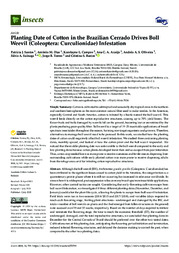Planting date of cotton in the Brazilian Cerrado drives boll weevil (coleoptera: curculionidae) infestation.
Planting date of cotton in the Brazilian Cerrado drives boll weevil (coleoptera: curculionidae) infestation.
Autoria: SANTOS, P. J.; DIAS, A. M.; CAMPOS, K. L.; ARAÚJO, A. C. A.; OLIVEIRA, A. A. S.; SUINAGA, F. A.; TORRES, J. B.; BASTOS, C. S.
Resumo: Cotton is cultivated in subtropical and seasonally dry tropical areas in the northern and southern hemispheres as the most common natural fiber used to make textiles. In the Americas, especially Central and South America, cotton is infested by a beetle named the boll weevil. This weevil feeds directly on the cotton reproductive structures, causing up to 70% yield losses. The flower buds and bolls damaged by weevils fall on the ground, becoming lost or are retained by the plants producing poor-quality fiber. Boll weevil is a target of 19–25 insecticide applications of broadspectrum insecticides throughout the season, harming non-target organisms and growers. Therefore, alternatives to manage boll weevil need to be pursued. In this work, we studied how the planting dates of cotton could negatively affect boll weevil infestation. We studied three contrasting planting dates, monthly spaced, and looked at how the cotton plant and the boll weevil responded. We noticed that the middle-planting date was unfavorable to the boll weevil compared to the early and late-planting dates because cotton plants developed faster then and so escaped from pest infestation. Thus, cotton crop seeded late was more prone to receive numerous and fertile insects dispersing from surrounding cultivations while early planted cotton was more prone to receive dispersing adults from the refuge areas avid for infesting cotton reproductive structures.
Ano de publicação: 2023
Tipo de publicação: Artigo de periódico
Unidade: Embrapa Hortaliças
Palavras-chave: Algodão, Anthonomus grandis grandis, Besouro, Bicudo, Cotton, Cultural control, Gossypium, Inseto
Observações
1 - Por padrão são exibidas publicações dos últimos 20 anos. Para encontrar publicações mais antigas, configure o filtro ano de publicação, colocando o ano a partir do qual você deseja encontrar publicações. O filtro está na coluna da esquerda na busca acima.
2 - Para ler algumas publicações da Embrapa (apenas as que estão em formato ePub), é necessário ter, no celular ou computador, um desses softwares gratuitos. Sistemas Android: Google Play Livros; IOS: iBooks; Windows e Linux: software Calibre.
Acesse outras publicações
Acesse a Base de Dados da Pesquisa Agropecuária (BDPA) para consultar o acervo completo das bibliotecas da Embrapa.

